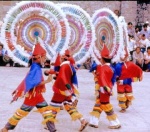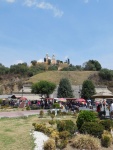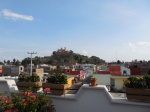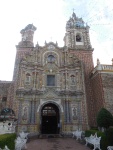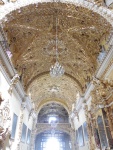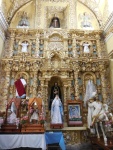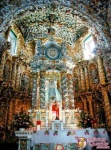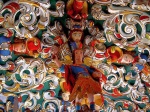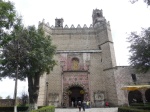Cuetzalan is a small town set high in the hills of the Sierra Norte, about three and a half hours from Puebla. Its hot, rainy, humid climate make it incredibly fertile and home to an astounding level of biodiversity. It is known for its strong indigenous traditions and Nahuatl-speaking Totonac Indian population, but tourism has rapidly increased since it was declared a Pueblo Mágico in 2002.
The town is named after the exquisite (and almost extinct) quetzal bird, native to Mexico and Central America, who makes its home in cloud forests at high altitude. It’s a beautiful, delicate little creature with plumage of red, green and blue, which was considered sacred by ancient Maya and Aztec people. Most famously, Aztec emperor Moctezuma II (ruler at the time of the Spanish conquest) wore an elaborate headdress of quetzal feathers on a base of gold encrusted with precious stones: it is currently on display at the Museum of Ethnology in Vienna, and the Mexicans are more than miffed about it. The quetzal continues to be the emblem of Cuetzalan, the crest of which inspires the headdress of the local indigenous Quetzal Dance, and this distinctive circular shape is depicted in all sorts of souvenirs sold there from napkin holders to necklaces.
Just outside of Cuetzalan is the archaeological site of Yohualichán: it consists of five pre-Hispanic buildings once home to the Totonac people, who were until the 19th century the world’s main producers of vanilla and whose territory stretched right from the highlands of northern Puebla to the coast of Veracruz. Set up on high with spectacular views over the jungle valley below, the site is very impressive. And as we so often find in Mexico, right outside the site is the church built by the Spanish when they arrived and tried to eradicate indigenous Mexican beliefs and traditions.
Also just outside of Cuetzalan is the Jardín Botanical Xoxoctic, a beautiful botanical garden which shows, protects and develops much of the area’s natural wildlife, including an astounding range of orchids, coffee, cinnamon, passion fruit, bamboo. Additionally, there is a wonderful butterfly sanctuary and a tree which ‘bleeds’ red sap, the Sangre de Grado (Dragon’s Blood).
The deeply curving roads in the area are nausea-inducing – you’ll need to alleviate your symptoms as soon as you arrive with some of the best local cuisine – tayoyos. Like little squashed dough balls, they are made from maize, filled with a spiced mix of chick pea and avocado, and topped with green or red salsa (or go for both to create the bandera, Mexican flag).
Cuetzalan’s remote location makes its central Zócalo (main square) and Parroquia (parish church) seem particularly impressive, and one wonders how on earth they were built long before proper roads and modern machinery. A big attraction for weekend tourists is the Sunday tianguis, its bustling market. Local people descend from the hills to the town in their thousands to sell their wares, and you can find pretty much anything. There is an amazing variety of handmade souvenirs at very reasonable prices, including lots of jewellery made from coffee beans, hand-embroidered blouses and beautiful rebozos, a kind of traditional Mexican wrapped scarf.
A short climb up the steep hillside away from the Zócalo is the church charmingly called Los Jarritos, which means ‘little jugs,’ named after the little jugs which decorate its tower.
It is especially lovely to wander the peaceful streets at night when there is a refreshing lack of traffic and minimal light pollution. Just opposite Los Jarritos is the bar Peña Los Jarritos which is a great relaxed hideout for the evening: it hosts its own pole for voladores who perform in the dark amongst the fireflies, making for a truly magical experience.
En route home, about two hours from Puebla and one hour from Cuetzalan, is the town of Zacapoaxtla. It is like a smaller, quieter version of Cuetzalan and is famed for the brave contribution its population made to the Batalla Cinco de Mayo. It’s worth stopping by for a wander, toilet stop, and to fill up on tayoyos (again) before heading home.
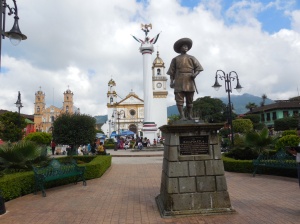
Visitors complain that the ‘original’ Cuetzalan is now little more than a legend owing to the huge boost in tourism it has seen in recent years. This may be true, but there’s no doubt that the increase in visitors provides an important flow of business for the locals, who are able to maintain their life and culture in the hills rather than flock to the cities. Furthermore, they benefit from being able to sell directly to consumers rather than through a middle-man who would take a handsome wedge of the profit. It’s also a fantastic opportunity for Mexicans young and old to escape from the cities and enjoy a slice of the incredibly beautiful nature and wildlife their homeland offers.




